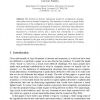Free Online Productivity Tools
i2Speak
i2Symbol
i2OCR
iTex2Img
iWeb2Print
iWeb2Shot
i2Type
iPdf2Split
iPdf2Merge
i2Bopomofo
i2Arabic
i2Style
i2Image
i2PDF
iLatex2Rtf
Sci2ools
BIRTHDAY
2008
Springer
2008
Springer
What Do Semantics Matter When the Meat Is Overcooked?
Abstract. We develop an abstract operational model for configuration management under service-oriented computing. This semantics is based on a graph-based representation of the configuration of global computers and an operational model of service-oriented dynamic reconfiguration based on a resolution-like mechanism similar to concurrent constraint programming. A resolution step involves a goal executed by a business activity and a clause that corresponds to a complex service. Unification captures service discovery, ranking and selection based on SLA-constraint optimisation and interpretations between specifications of conversations expected by the goal and provided by the discovered service. The resolvent is a reconfiguration of the original business activity that results from binding the goal with the discovered service.
Abstract Operational Model | Applied Computing | BIRTHDAY 2008 | Operational Model | Service-oriented Dynamic Reconfiguration |
| Added | 08 Nov 2010 |
| Updated | 08 Nov 2010 |
| Type | Conference |
| Year | 2008 |
| Where | BIRTHDAY |
| Authors | José Luiz Fiadeiro |
Comments (0)

